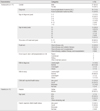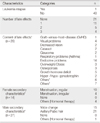Abstract
Purpose
This study was conducted to examine the late effects, social adjustment, and quality of life in adolescents who had been completely treated for childhood leukemia and their parents.
Methods
Participants consisted of 41 pairs of adolescent survivors (13-18 years) and their parents. Parents checked for their child's physical late effects. The Korean Version of Post-Traumatic Symptoms for psychological late effects, social functioning questionnaire for social adjustment and the PedsQL 4.0 Generic Core Scales for quality of life were completed by adolescents and parents. Data were analyzed using SPSS.
Results
Twenty out of 41 adolescents had one or more physical late effects. Adolescents showed more serious psychological late effect than parents. Five children and seven parents had above cut-off scores and they were considered the high risk group for posttraumatic symptoms. Parent-reported scores were significantly higher than child-reported scores in terms of social adjustment and emotional functioning of quality of life. Low school functioning in adolescents was associated with physical late effects.
Figures and Tables
References
1. Ministry of Health & Welfare, Korea Central Cancer Registry, National Cancer Center. Annual report of cancer statistics in Korea in 2010. Seoul: Ministry of Health & Welfare;2012.
2. Hunger SP, Lu X, Devidas M, Camitta BM, Gaynon PS, Winick NJ, et al. Improved survival for children and adolescents with acute lymphoblastic leukemia between 1990 and 2005: A report from the children's oncology group. J Clin Oncol. 2012; 30(14):1663–1669. http://dx.doi.org/10.1200/jco.2011.37.8018.
3. Haddy TB, Mosher RB, Reaman GH. Late effects in long-term survivors after treatment for childhood acute leukemia. Clin Pediatr (Phila). 2009; 48(6):601–608. http://dx.doi.org/10.1177/0009922809332680.
4. Löf CM, Winiarski J, Giesecke A, Ljungman P, Forinder U. Health-related quality of life in adult survivors after paediatric allo-SCT. Bone Marrow Transplant. 2009; 43(6):461–468. http://dx.doi.org/10.1038/bmt.2008.338.
5. Clarke SA, Skinner R, Guest J, Darbyshire P, Cooper J, Vora A, et al. Clinical outcomes and health-related quality of life (HRQOL) following haemopoietic stem cell transplantation (HSCT) for paediatric leukaemia. Child Care Health Dev. 2011; 37(4):571–580. http://dx.doi.org/10.1111/j.1365-2214.2010.01182.x.
6. Edelstein K, D'Agostino N, Bernstein LJ, Nathan PC, Greenberg ML, Hodgson DC, et al. Long-term neurocognitive outcomes in young adult survivors of childhood acute lymphoblastic leukemia. J Pediatr Hematol Oncol. 2011; 33(6):450–458. http://dx.doi.org/10.1097/MPH.0b013e31820d86f2.
7. Gurney JG, Krull KR, Kadan-Lottick N, Nicholson HS, Nathan PC, Zebrack B, et al. Social outcomes in the childhood cancer survivor study cohort. J Clin Oncol. 2009; 27(14):2390–2395. http://dx.doi.org/10.1200/jco.2008.21.1458.
8. You MA. Content analysis on psychosocial adjustment of adolescent survivors of leukemia. J Korean Acad Child Health Nurs. 2006; 12(3):304–313.
9. Kim YJ, Cha HG, Kim CA, Park YJ, Kim HJ, Seo JJ, et al. Child cancer survivors' quality of life based on their parents' support and past history. J Korean Acad Psychiatr Ment Health Nurs. 2008; 17(1):85–96.
10. Kim MA, Yi J. Psychological distress in adolescent and young adult survivors of childhood cancer in Korea. J Pediatr Oncol Nurs. 2013; 30(2):99–108. http://dx.doi.org/10.1177/1043454213478469.
11. Faul F, Erdfelder E, Lang AG, Buchner A. G*Power 3: A flexible statistical power analysis program for the social, behavioral, and biomedical sciences. Behav Res Methods. 2007; 39(2):175–191.
12. Korea Centers for Disease Control and Prevention. The Korean Pediatric Society. The Committee for the Development of Growth Standard for Korean Children and Adolescents. 2007 Korean national growth charts: Review of developmental process and outlook [Internet]. Seoul: Korea Centers for Disease Control and Prevention;2007. 11. cited 2013 August 1. Available from: http://www.cdc.go.kr/CDC/cms/content/03/12103_view.html.
13. Greenwald R, Rubin A. Assessment of posttraumatic symptoms in children: Development and preliminary validation of parent and child scales. Res Soc Work Pract. 1999; 9(1):61–75. http://dx.doi.org/10.1177/104973159900900105.
14. Lee KM, Jeong SH, Lee WK, Chung US. Reliability and validity of the Korean version of the child report of post-traumatic symptoms (CROPS) and the parent report of post-traumatic symptoms (PROPS). J Korean Acad Child Adolesc Psychiatry. 2011; 22(3):169–181.
15. Meeske KA, Ruccione K, Globe DR, Stuber ML. Posttraumatic stress, quality of life, and psychological distress in young adult survivors of childhood cancer. Oncol Nurs Forum. 2001; 28(3):481–489.
16. Kamibeppu K, Sato I, Honda M, Ozono S, Sakamoto N, Iwai T, et al. Mental health among young adult survivors of childhood cancer and their siblings including posttraumatic growth. J Cancer Surviv. 2010; 4(4):303–312. http://dx.doi.org/10.1007/s11764-010-0124-z.
17. Varni JW, Seid M, Kurtin PS. PedsQL 4.0: Reliability and validity of the pediatric quality of life inventory version 4.0 generic core scales in healthy and patient populations. Med Care. 2001; 39(8):800–812.
18. Kook SH, Varni JW. Validation of the Korean version of the pediatric quality of life inventory 4.0 (PedsQL) generic core scales in school children and adolescents using the Rasch model. Health Qual Life Outcomes. 2008; 6:41. http://dx.doi.org/10.1186/1477-7525-6-41.
19. Bertorello N, Manicone R, Galletto C, Barisone E, Fagioli F. Physical activity and late effects in childhood acute lymphoblastic leukemia long-term survivors. Pediatr Hematol Oncol. 2011; 28(5):354–363. http://dx.doi.org/10.3109/08880018.2010.550987.
20. Pemberger S, Jagsch R, Frey E, Felder-Puig R, Gadner H, Kryspin-Exner I, et al. Quality of life in long-term childhood cancer survivors and the relation of late effects and subjective well-being. Support Care Cancer. 2005; 13(1):49–56. http://dx.doi.org/10.1007/s00520-004-0724-0.
21. Michel G, Bordigoni P, Simeoni MC, Curtillet C, Hoxha S, Robitail S, et al. Health status and quality of life in long-term survivors of childhood leukaemia: The impact of haematopoietic stem cell transplantation. Bone Marrow Transplant. 2007; 40(9):897–904. http://dx.doi.org/10.1038/sj.bmt.1705821.
22. Asner S, Ammann RA, Ozsahin H, Beck-Popovic M, von der Weid NX. Obesity in long-term survivors of childhood acute lymphoblastic leukemia. Pediatr Blood Cancer. 2008; 51(1):118–122. http://dx.doi.org/10.1002/pbc.21496.
23. Love E, Schneiderman JE, Stephens D, Lee S, Barron M, Tsangaris E, et al. A cross-sectional study of overweight in pediatric survivors of acute lymphoblastic leukemia (ALL). Pediatr Blood Cancer. 2011; 57(7):1204–1209. http://dx.doi.org/10.1002/pbc.23010.
24. Oeffinger KC, Mertens AC, Sklar CA, Yasui Y, Fears T, Stovall M, et al. Obesity in adult survivors of childhood acute lymphoblastic leukemia: A report from the childhood cancer survivor study. J Clin Oncol. 2003; 21(7):1359–1365.
25. Garmey EG, Liu Q, Sklar CA, Meacham LR, Mertens AC, Stovall MA, et al. Longitudinal changes in obesity and body mass index among adult survivors of childhood acute lymphoblastic leukemia: A report from the childhood cancer survivor study. J Clin Oncol. 2008; 26(28):4639–4645. http://dx.doi.org/10.1200/jco.2008.16.3527.
26. Wenninger K, Helmes A, Bengel J, Lauten M, Völkel S, Niemeyer CM. Coping in long-term survivors of childhood cancer: Relations to psychological distress. Psychooncology. 2013; 22(4):854–861. http://dx.doi.org/10.1002/pon.3073.
27. Nuss SL, Wilson ME. Health-related quality of life following hematopoietic stem cell transplant during childhood. J Pediatr Oncol Nurs. 2007; 24(2):106–115. http://dx.doi.org/10.1177/1043454206296033.
28. Harila MJ, Salo J, Lanning M, Vilkkumaa I, Harila-Saari AH. High health-related quality of life among long-term survivors of childhood acute lymphoblastic leukemia. Pediatr Blood Cancer. 2010; 55(2):331–336. http://dx.doi.org/10.1002/pbc.22531.




 PDF
PDF ePub
ePub Citation
Citation Print
Print







 XML Download
XML Download